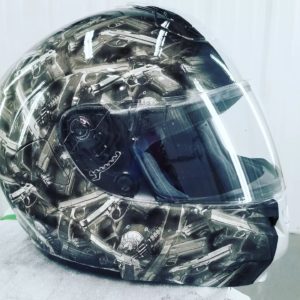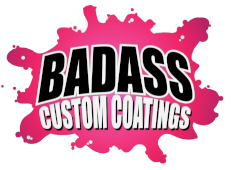What is Hydro Dipping and Where Did it Come From?
Intro
Hydro dipping (also known as hydrographics, water transfer printing, and sometimes called cubic printing) has been around since the early 1990s. Lately, though, hydro dipping has quickly become one of the most exciting trends in customization. So what is hydro dipping, where did it come from and how did it evolve to the growing side-hustle and full time business we are seeing today?
In this article, we’ll look at the history of hydro dipping from its beginnings to its most recent developments. Once you have an idea of where hydro dipping came from, maybe it will give you an idea of where to take your own hydro dip projects next!
What Is Hydro Dipping?
Simply put, hydro-dipping is the transfer of a design onto a solid object by placing a medium on water and ‘dipping’ (slowly pushing) the item you want decorated through that medium. While some people do use spray paint to accomplish a random design on objects, the results from doing this are somewhat unpredictable.
Here, we will focus on transferring a pre-printed design onto your objects through use of hydrographic film. Using pre-printed designs results in consistent, expected and reproduceable results. For those who want their own unique design, BadAss Custom Coatings can create a custom hydrographic film from your images! Click here to find out more about our Custom Design hydrographic film service.
 For the hydro dipping process we discuss on this site, a water soluble film has been printed with a design or pattern. That film is placed on the surface of water filling a container and sprayed with an activator. Then the item that you want to be decorated with the design is slowly pushed through the film that has been softened by the activator. Water wants to flow around the item as it’s being pushed in, and it’s this natural pressure of the water that transfers the pattern directly onto the item.
For the hydro dipping process we discuss on this site, a water soluble film has been printed with a design or pattern. That film is placed on the surface of water filling a container and sprayed with an activator. Then the item that you want to be decorated with the design is slowly pushed through the film that has been softened by the activator. Water wants to flow around the item as it’s being pushed in, and it’s this natural pressure of the water that transfers the pattern directly onto the item.
This is definitely an oversimplification of the process. To find out the full details of the process, please see The Step By Step Guide to Hydro Dipping!
The History of Hydro Dipping
 When you really get into a hobby and you’re literally waiting for paint to dry, you sometimes get curious about where it all began.
When you really get into a hobby and you’re literally waiting for paint to dry, you sometimes get curious about where it all began.
Digging for the roots of the origins of Hydro Dipping can be an interesting exercise because companies change their names and are acquired over the decades. and because people on the internet take the easy way out in their research.
However, I think I have it figured out, for what it’s worth.
The company Taica claims the invention of the Cubic Printing 3D decoration process in August of 1974. You can click on the image to the left to view the screen shot or click on the following link to see the information on their own site. https://taica.co.jp/en/history/
The Taica company also says that it applied for the domestic and foreign patents in that same year.
I’ve found the wrong information regarding the dates on a lot of sites around the internet. A lot of people who search for this information get confused by using the Google patent search which puts the US patent date at a confusing 1982.
However, if you search the (REALLY ugly but official) US Patent and Trademark Office database for patent number 4,010,057 you will find the patent was filed in 1975 and the Japanese Patents were filed in 1974. If you want to try it yourself, here’s the link https://patft.uspto.gov/ but don’t say I didn’t warn you about that site!
Also, I certainly don’t blame anyone for having the wrong information on this just because searching that patent site is not as easy as searching Google, for sure!
Regardless of the patent date, the patent tells us that the inventor of record is Motoyasu Nakanishi, and the patent was assigned to Kabushiki Kaisha Kobayashi.
A printing apparatus wherein a thin film on which a pattern is printed is floated on the surface of liquid and the pattern is transferred onto a surface of an object to be printed with the pattern utilizing the liquid pressure by submerging the object into the liquid while pressing the object onto the thin film.
The inventor of record is Motoyasu Nakanishi who actually holds 29 patents in the database.
I think it’s pretty safe to assume that the claim from Taica is valid and that Kabushiki Kaisha Kobayashi (the assignee on the patent) is previous incarnation or holding company of their own company. Unravelling the corporate spaghetti here would be pointless since there is no real value in Taico lying about the claim. If it were not true, someone with prior knowledge would undoubtedly call them out on it.
To go on, though: That original hydro dipping process described the features of floating a film with a pattern on it on water and using the liquid pressure to transfer that pattern onto an object. However, they were talking about this in the context of a “printing apparatus”. If you do look it up in the Google patent search, you will be able to see the concept diagrams for that device.
That sort of device is still in use today in commercial applications around the world. If you ever see a woodgrain on a piece of plastic, that is almost assuredly created through use of Motoyasu Nakanishi’s water transfer printing process.
From those somewhat confusing beginnings to today, I think the evolution from an industrial process to the home business of hydro dipping that we see blowing up today was pretty much inevitable.
The home hydro dipping process is so simple that you can do it with your kids and the results are amazing!
With the growth of the home market, the selection of hydro graphic films is growing constantly! And while BadAss Custom Coatings already has the largest selection of hydrographic films in Canada, we are always making sure we keep up with what’s new.
So why don’t you check out what’s new in our hydro dipping films too. Click here to see what we have in New Films and happy dipping.
